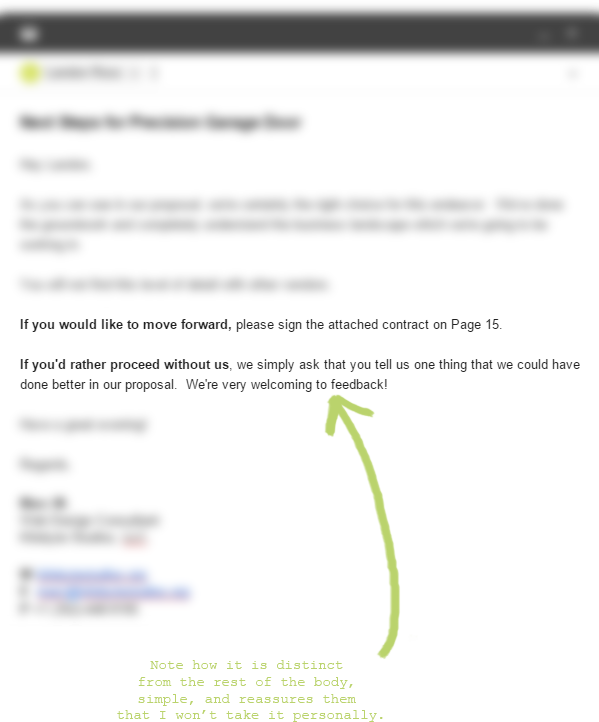You’re getting ready to close the big deal….you’ve been schmoozing this new customer for days.
You get all worked up about your sales pitch and rehearse it extensively…you give that presentation all you’ve got and damnit you did you hair for this.
But then, you commit the cardinal sin of sales closing. The one thing you should never say when you’re trying to close a prospective client:
So…what do you think?
Most freelancers close a proposal this way and it’s shockingly-ineffective. In the next 5 minutes, I’m going to show you a technique that I use with all my prospects that quite literally cannot fail.
Getting to the point…
I won’t make you sit through the entire blog post to figure it out (we’ll go into detail later), but here’s what I say:
If you’d like to move forward, do “X”, if not, please tell me one thing that I can do to improve my proposals in the future.
That’s it.
This one little change to my proposal strategy has helped me learn so much about what people want to hear (and consequently, I’ve closed many more deals) .
I’ve had a 100% success rate with this close because not only is it incredibly-influential, I’ve also changed the success criteria for the deal! (I know, I bent the rules — forgive me!)
Okay…so how do I do this effectively?
Good question. Honestly, it’s quite important that you execute it in the right context, so here’s some caveats that hold true to maximize the potential:
- Do some surface-level qualification first.
Make sure that the people you’re talking to are legitimately looking to use your product/service. If you open yourself up to feedback from people who weren’t actually interested in buying, you’re going to make changes to your proposal strategy that aren’t based in reality.
- Pause.
If you’re talking in person (or on a phone/webcam), the power of silence is incredible (I’ll probably do another post on this later), but once you deliver this line you must wait for a response.
- Distinguish the request.
If you’re talking via email, just make sure that the question is bold and clearly separate (distinct) from the body of your email. This ensures that the recipient doesn’t have to put in much effort to get to the point.
- Reassure.
Make sure that the recipient knows that you won’t take it personally. Most people (especially in Western cultures) will be terrified of giving you real negative feedback.
You have to break down this barrier!
I’ve left an example of when I’ve done this before so you can have see what it looks like in context:
Oh yeah, that’s good.
So…why does this work?
At a surface level, there’s 2 principles of influence at work here:
- I’m appealing to the human nature of the recipient.
- I’m asking him to provide legitimate objections to my proposal (instead of the default emotional resistance to purchasing).
When I ask this, I bring the conversation from “formal proposal engagement”, back to “I’m working with a human being to whom I can relate”. This makes it much easier for the recipient to understand that I’m in their court (and I am).
Further, when you ask someone for feedback, you’re also asking for something else: you need them to find something wrong with your proposal. If there’s really nothing wrong with the proposal (and yes, people will reject even the best proposals for emotional reasons), then it becomes explicit and a purchase decision is then made.
If there’s something wrong with your proposal, you then have a chance to address it, or simply learn and move on.
Finally, the main reason why I truly appreciate this close is that it re-frames the conversation from “win/lose” to “win/win”.
More importantly, you stop leaving with nothing. You either win, or you learn. Losing is no longer part of the equation.
…you either win, or you learn. Losing is no longer part of the equation.
The future of your proposals is in your hands (or…mouth?)
Make a vow to never say “so..what do you think?” again.
Unless, of course, you’re writing a blog post about why you should never say it.
Re-frame every proposal you do from here on out as a learning experience as opposed to a nerve-wrecking rejection. You can thank me later.
Call to Action
Now, either comment below with what you enjoyed about this blog post, or tell me how I can improve for future articles… 😉
Best of luck in the field folks, hope to see you out there!
